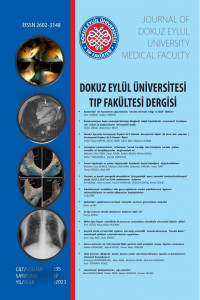The Use of GLUT-1, Ki-67 and PCNA Antibodies as Immunohistochemical Markers in Histopathological Differential Diagnosis of Psoriasis and Chronic Spongiotic Dermatitits
Öz
ABSTRACT
Introduction: The present study aims to investigate the benefits of the
immunohistochemical antibodies of glucose transporter 1 (GLUT-1), the
nuclear protein Ki-67, and proliferating cell nuclear antigen (PCNA) to
distinguish between psoriasis and chronic spongiotic dermatitits.
Materials and Methods: We evaluated 32 cases of psoriasis and 35 cases of
spongiotic dermatitis that had been clinicopathologically diagnosed. Skin
tissue from reduction mammoplasty procedures was used as a control group.
Skin biopsy sections stained with H&E were examined. Additional
immunohistochemistry was performed, including Ki-67, PCNA and GLUT-1.
Histological findings were also noted
Results: There was no significant difference between psoriasis and chronic
spongiotic dermatitits groups in the results of Ki-67 or PCNA staining. GLUT1 distribution was also similar; however, there was a difference between the
groups concerning GLUT-1 intensity. The percentage of cases with moderate
GLUT-1 staining was higher in the psoriasis group, whereas the percentage
of strong staining was higher in the chronic spongiotic dermatitits group.
Most of the examined histopathological features of psoriasis and chronic
spongiotic dermatitits cases were different.
Conclusion: The intensity of GLUT-1 staining with the appropriate
histopathological and clinical findings may have a limited benefit in the
differential diagnosis of psoriasis and chronic spongiotic dermatitits.
Anahtar Kelimeler
chronic spongiotic dermatitits glucose transporter 1 immunohistochemistry Ki-67 proliferating cell nuclear antigen psoriasis
Kaynakça
- 10. Abdou AG, Maraee AH, Eltahmoudy M, El-Aziz RA. Immunohistochemical expression of GLUT-1 and Ki67 in chronic plaque psoriasis.Am J Dermatopathol. 2013 Oct;35(7):731-7. PMID: 23392136 doi: 10.1097/DAD.0b013e3182819da6
- 11. Tao J, Yang J, Wang L, Li Y, Liu YQ, Dong J, Wen X, Shen GX and Tu YT. Expression of GLUT-1 in psoriasis and the relationship between GLUT-1 upregulation induced by hypoxia and proliferation of keratinocyte growth. J Dermatol Sci. 2008 Sep; 51(3):203-7. PMID: 18565734 doi: 10.1016
- 12. Hodeib AAH, Neinaa YMEH, Zakaria SS, Alshenawy HAS. Glucose transporter-1 (GLUT-1) expression in psoriasis:correlation with disease severity.International Journal of Dermatology 2018; 57(8):943-51. PMID: 29797802 doi: 10.1111/ijd.14037
- 13. Mıchaeelsson G, Ahs S, Hammarstro I, Lundin IP, Hagforsen E. Gluten-free Diet in Psoriasis Patients with Antibodies to Gliadin Results in Decreased Expression of Tissue Transglutaminase and Fewer Ki67 + Cells in the Dermis. ActaDermVenereol 2003; 83: 425–429. PMID: 14690336 doi: 10.1080/00015550310015022
The Use of GLUT-1, Ki-67 and PCNA Antibodies as Immunohistochemical Markers in Histopathological Differential Diagnosis of Psoriasis and Chronic Spongiotic Dermatitits
Öz
Introduction: The present study aims to investigate the benefits of the
immunohistochemical antibodies of glucose transporter 1 (GLUT-1), the
nuclear protein Ki-67, and proliferating cell nuclear antigen (PCNA) to
distinguish between psoriasis and chronic spongiotic dermatitits.
Materials and Methods: We evaluated 32 cases of psoriasis and 35 cases of
spongiotic dermatitis that had been clinicopathologically diagnosed. Skin
tissue from reduction mammoplasty procedures was used as a control group.
Skin biopsy sections stained with H&E were examined. Additional
immunohistochemistry was performed, including Ki-67, PCNA and GLUT-1.
Histological findings were also noted
Results: There was no significant difference between psoriasis and chronic
spongiotic dermatitits groups in the results of Ki-67 or PCNA staining. GLUT1 distribution was also similar; however, there was a difference between the
groups concerning GLUT-1 intensity. The percentage of cases with moderate
GLUT-1 staining was higher in the psoriasis group, whereas the percentage
of strong staining was higher in the chronic spongiotic dermatitits group.
Most of the examined histopathological features of psoriasis and chronic
spongiotic dermatitits cases were different.
Conclusion: The intensity of GLUT-1 staining with the appropriate
histopathological and clinical findings may have a limited benefit in
Anahtar Kelimeler
chronic spongiotic dermatitits glucose transporter 1 immunohistochemistry Ki-67 proliferating cell nuclear antigen psoriasis
Kaynakça
- 10. Abdou AG, Maraee AH, Eltahmoudy M, El-Aziz RA. Immunohistochemical expression of GLUT-1 and Ki67 in chronic plaque psoriasis.Am J Dermatopathol. 2013 Oct;35(7):731-7. PMID: 23392136 doi: 10.1097/DAD.0b013e3182819da6
- 11. Tao J, Yang J, Wang L, Li Y, Liu YQ, Dong J, Wen X, Shen GX and Tu YT. Expression of GLUT-1 in psoriasis and the relationship between GLUT-1 upregulation induced by hypoxia and proliferation of keratinocyte growth. J Dermatol Sci. 2008 Sep; 51(3):203-7. PMID: 18565734 doi: 10.1016
- 12. Hodeib AAH, Neinaa YMEH, Zakaria SS, Alshenawy HAS. Glucose transporter-1 (GLUT-1) expression in psoriasis:correlation with disease severity.International Journal of Dermatology 2018; 57(8):943-51. PMID: 29797802 doi: 10.1111/ijd.14037
- 13. Mıchaeelsson G, Ahs S, Hammarstro I, Lundin IP, Hagforsen E. Gluten-free Diet in Psoriasis Patients with Antibodies to Gliadin Results in Decreased Expression of Tissue Transglutaminase and Fewer Ki67 + Cells in the Dermis. ActaDermVenereol 2003; 83: 425–429. PMID: 14690336 doi: 10.1080/00015550310015022
Ayrıntılar
| Birincil Dil | İngilizce |
|---|---|
| Konular | Endokrinoloji |
| Bölüm | Araştırma Makaleleri |
| Yazarlar | |
| Yayımlanma Tarihi | 30 Ağustos 2021 |
| Gönderilme Tarihi | 17 Şubat 2021 |
| Yayımlandığı Sayı | Yıl 2021 Cilt: 35 Sayı: 2 |


